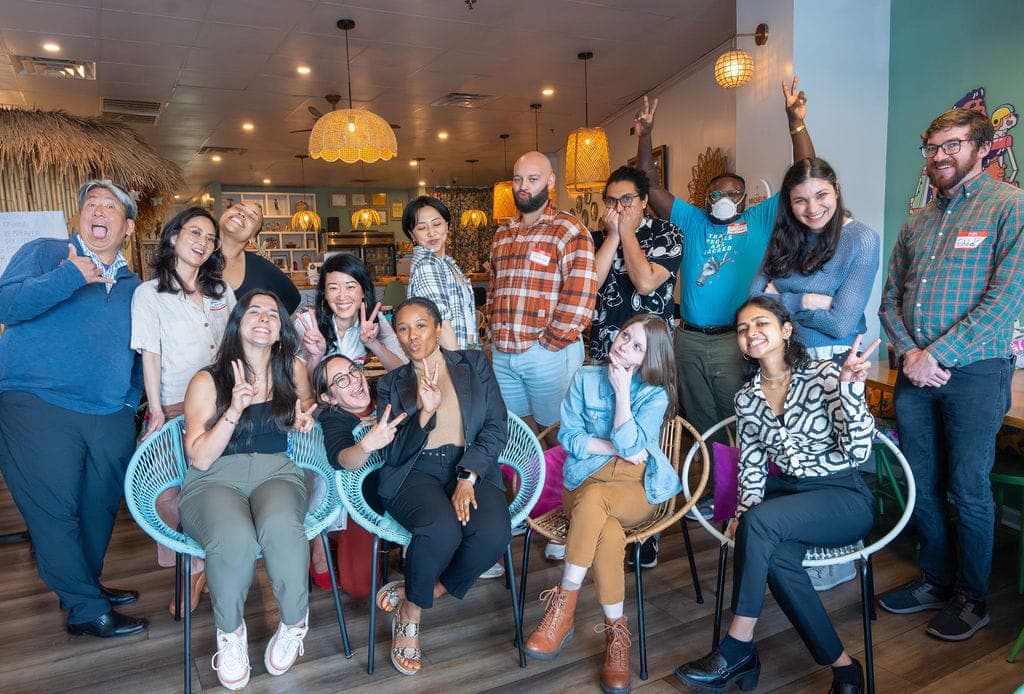
News
By Courtney Cole, May 23, 2024
Healing Our Highways is a grant program led by Smart Growth America’s Arts and Culture team providing funding and technical assistance for arts and culture projects that confront the harms perpetuated through our transportation system on marginalized communities of color. On May 15, 2024, a cozy Filipino restaurant in a suburban Atlanta Asian shopping plaza was filled with energy, connection, and delicious food as the Healing Our Highways cohort of artists and cultural workers deliberated on strategies for community organizing, building power, and making change.

This in-person convening in Atlanta followed virtual sessions that focused on research and reporting to leverage data and embed smart growth and climate justice into the teams’ projects. The remainder of the Healing Our Highways program will include further one-on-one coaching. Ultimately, the program will result in community-facing activities and a national webinar in the fall to share reflections.
The goal for this gathering of Healing Our Highways project teams, organized by SGA’s Arts and Culture staff and facilitated by DLS, was to hone in on cultural and community organizing strategies to shift power and policy by and within marginalized communities, creating power and collective liberation.
Gathering a community of support


Fatima Elkott and Naya Young represented the Tampa Heights, Florida, team, which seeks to preserve a critical community hub and promote climate resilience through cultural preservation, performances, and activism.
Atlanta-based artists Emma Chammah and Eddie Farr are creating a web-based application using traffic camera data to help community members visualize and reflect on a future public transit system with more climate-friendly options.
Victoria Garcia and Daniel Pizarro represented the Buford Highway People’s Hub, which seeks to enhance its existing community-based programs serving Latinx, working-class, immigrant youth and families by incorporating more of a focus on climate resilience and transportation.
Lakshmy Narayanan and Anthony Correa represented the Boyle Heights, California team. The Boyle Heights team seeks to set new precedents for community planning by co-creating new, shared language around mobility resilience informed by communal knowledge, collective memory, and cultural traditions.
Click here to learn more about each of these projects.
Building community power


Erik Takeshita, co-director of the Culture and Community Power Fund, set the tone for the day by sharing observations gleaned from his decades-long experience working across arts and culture, community development, and philanthropy. Providing insight into change-making through arts and culture, Erik recognized that “While this work can be amazing and lead to equitable outcomes for people, it doesn’t automatically do that. You have to start out with that intention.” He also reflected on his prior experiences working in arts and culture and community development, which reinforced that “communities need to build power—which means the ability to set an agenda, realize that agenda, and maintain it,” and finally, “We have to own our own stories, we have to own our own narrative. We have to be able to tell people why we love our places.”
These deep convictions directly tied into the day’s first group activity, led by SGA Arts & Culture Director Marian Liou and Atlanta artist Eddie Farr, which asked attendees to share and assemble totems or ephemera brought from home into a group art project. These objects were meant to represent, respectively, one’s inner child, a power each person is stepping into or manifesting, the community that raised them, and the community each person is nurturing to entrust to the next generation.
After the art-making activity, DLS led the cohort through a series of exercises around community planning, power mapping, and strategy building. Through a city planning exercise, attendees explored the complexity and interconnectedness of housing, retail, community services, green spaces, industrial facilities, and transportation systems.


Culture is critical to power building—it can accelerate and sustain power.
Erik Takeshita
The system isn't broken. It's working exactly as designed.
LP Green
Building off this understanding, the group participated in a power mapping exercise, framed around the oft-sought, oft-failed goal of expanding public transit in Atlanta. The group named key players who could sway this goal, gauged how much power those players have over the issue, and identified their respective positions (support, oppose, neutral). The efforts of community advocates hinge on the decisions and perceptions of key power brokers and decision makers, so deciding where to spend energy and direct pressure is an invaluable skill that the participants will continue honing in their work ahead.
The teams then began building out strategies for their projects, working collaboratively to identify existing resources, internal challenges, and short-, intermediate-, and long-term goals. The final activity of the day left teams with tangible next steps to further develop and activate their Healing Our Highways projects.
The day concluded with each person reflecting on their takeaways, beginning with the head (something they learned), the heart (something they are feeling), and the hand (an action they plan on taking following the event). It was evident that everyone felt equipped with new ideas or framing, full of gratitude, and reinvigorated to continue building power within their communities.

About Smart Growth America's Arts & Culture program
Smart Growth America (SGA) supports communities through technical assistance, advocacy, and thought leadership to realize our vision of livable places, healthy people, and shared prosperity. SGA’s Arts and Culture program advances racial equity and climate justice within smart growth through creative, cultural power-building led by communities of color. The vision of the Arts and Culture program is that communities that have been marginalized and harmed by the systems and sectors in which SGA works are centered in and leading smart growth efforts, through the continuing practice of their creative and cultural imagination and power. Artists, culture bearers, cultural workers, and designers are essential leaders, collaborators, and instigators in this work. Learn more.
Related News

© 2025 Smart Growth America. All rights reserved
Site By3Lane Marketing


























